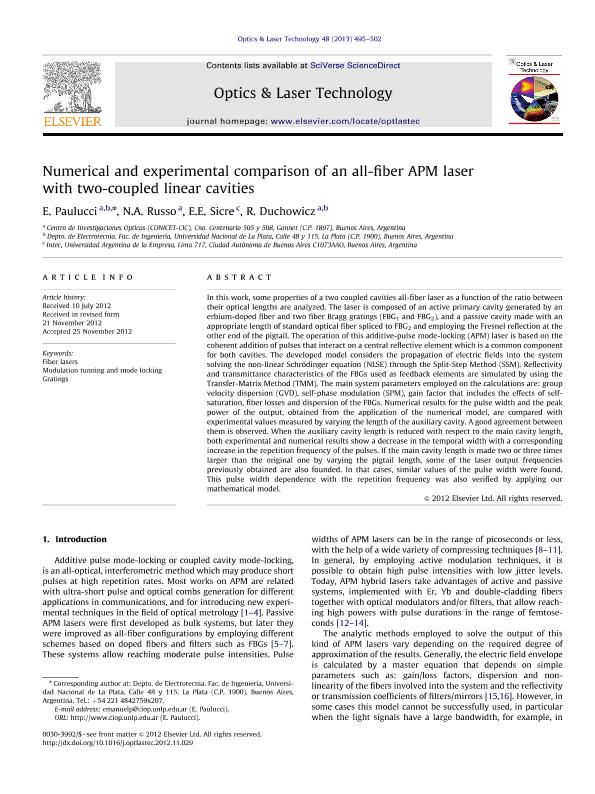Artículo
Numerical and experimental comparison of an all-fiber APM laser with two-coupled linear cavities
Fecha de publicación:
06/2013
Editorial:
Elsevier
Revista:
Optics and Laser Technology
ISSN:
0030-3992
Idioma:
Inglés
Tipo de recurso:
Artículo publicado
Clasificación temática:
Resumen
In this work, some properties of a two coupled cavities all-fiber laser as a function of the ratio between their optical lengths are analyzed. The laser is composed of an active primary cavity generated by an erbium-doped fiber and two fiber Bragg gratings (FBG1 and FBG2), and a passive cavity made with an appropriate length of standard optical fiber spliced to FBG2 and employing the Fresnel reflection at the other end of the pigtail. The operation of this additive-pulse mode-locking (APM) laser is based on the coherent addition of pulses that interact on a central reflective element which is a common component for both cavities. The developed model considers the propagation of electric fields into the system solving the non-linear Schrödinger equation (NLSE) through the Split-Step Method (SSM). Reflectivity and transmittance characteristics of the FBGs used as feedback elements are simulated by using the Transfer-Matrix Method (TMM). The main system parameters employed on the calculations are: group velocity dispersion (GVD), self-phase modulation (SPM), gain factor that includes the effects of self-saturation, fiber losses and dispersion of the FBGs. Numerical results for the pulse width and the peak power of the output, obtained from the application of the numerical model, are compared with experimental values measured by varying the length of the auxiliary cavity. A good agreement between them is observed. When the auxiliary cavity length is reduced with respect to the main cavity length, both experimental and numerical results show a decrease in the temporal width with a corresponding increase in the repetition frequency of the pulses. If the main cavity length is made two or three times larger than the original one by varying the pigtail length, some of the laser output frequencies previously obtained are also founded. In that cases, similar values of the pulse width were found. This pulse width dependence with the repetition frequency was also verified by applying our mathematical model.
Palabras clave:
Fiber Lasers
,
Modulation Tunning And Modelocking
,
Gratings
Archivos asociados
Licencia
Identificadores
Colecciones
Articulos(CIOP)
Articulos de CENTRO DE INVEST.OPTICAS (I)
Articulos de CENTRO DE INVEST.OPTICAS (I)
Citación
Paulucci, Emanuel; Russo, Nélida A.; Sicre, Enrique Eduardo; Duchowicz, Ricardo; Numerical and experimental comparison of an all-fiber APM laser with two-coupled linear cavities; Elsevier; Optics and Laser Technology; 48; 6-2013; 495-502
Compartir
Altmétricas




